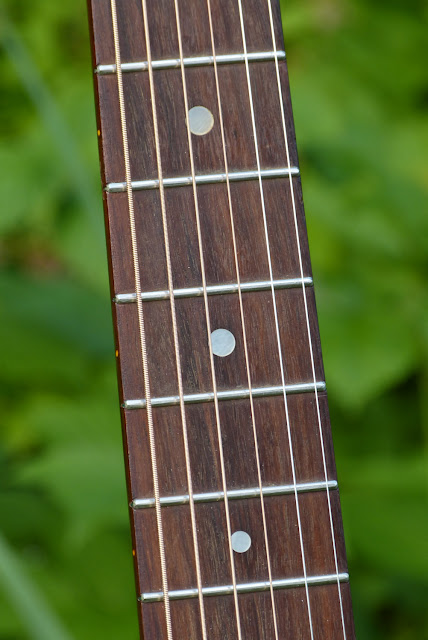1971 Martin 0-18 Flattop Guitar
0-18s are stalwart (and popular) little guitars, and this one is as punchy as ever. It's also in pretty good shape, with only a couple of small impact cracks on the lower-bout-side and all of its original fittings extant, save a new pickguard (the original black ones always curl-up and fall off).
This is a consignor's instrument and work on it included a fret level/dress, the new pickguard, a good setup, and some "bridge fussing." The bridge had been shaved a little and a sort of gross varnish had been put over it, so I sanded it a bit, polished it up, and finished it more per modern Martin specs. The saddle is now compensated properly, too, and string ramps mean that despite a low saddle, back-angle is good and the guitar sounds authoritative. The neck is straight, it's strung with 52w, 40w, 30w, 20w, 16, 12 strings, it sounds excellent, and it's ready to go. Action is spot-on at 3/32" EA and 1/16 DGBE at the 12th fret.
There's use-wear throughout with light scratching here and there and some finish check in various places, but overall it looks good. The top finish has certainly yellowed to a buttery-orange color that's very satisfying. The grain in the spruce on the top is somewhat wide, giving a folksy appearance to the instrument.
The rosewood veneer at the headstock looks great. The nut is original, has a 1 11/16" width, and the neck has a medium C-shaped profile.
The rosewood board has a light radius and is a little more "cinnamon brown" than many older, darker rosewood boards.
While the tortoise pickguard is not the black that the stock one would be, I think it looks a heck of a lot better. I make these by tracing the outline of the old pickguard's area and then cutting a new one to the same shape. It's a simple stick-on pickguard, so it won't cause trouble (hairline cracks) down the road in the wood.
The rosewood used for the bridge is super-dense, super-oily stuff. While I cleaned-up the bridge's look, I also filled and redrilled the pinholes to make sure the ball-ends sat snug at the bridge plate. These '70s Martins have rosewood bridge plates, but unlike the dreadnought-sized models, the size of the plates on these guitars is comparable to the small maple plates found on the earlier 0-through-000 models.
The back has some scritchy-scratch, but the mahogany has a nice, deep, rich color.
So -- 5 nickel-plated tuners and 1 chrome-plated tuner -- does this mean Martin grabbed from the wrong box for one or that one is a replacement? Grover only made this type of unit for a little while, so I have a feeling that it was just a wrong grab on Martin's part! When they were new, it would've been hard to tell the difference in plating in a fast-paced factory setting.
One tuner has a slightly bent shaft, but I've lubed all of them, and they're working just fine.
One tuner has a slightly bent shaft, but I've lubed all of them, and they're working just fine.
Here's a tiny old punched-in 1" crack repair. This stuff happens when a guitar gets bumped against a table or something like that. It's stable.
There's this 1 1/2" repaired hairline right next to the above one.
A beat-up but functional '70s Martin hard case comes with it. Orange lining!


























Comments